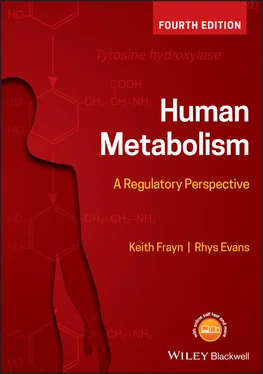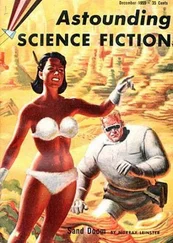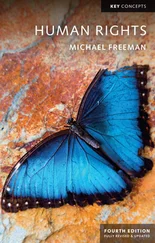15 CHAPTER 11 Energy balance and body weight regulation 11.1 Energy balance and body weight 11.2 Energy balance 11.3 Conditions of low body weight 11.4 Treatment of obesity Note
16 CHAPTER 12 Diabetes mellitus 12.1 Different types of diabetes 12.2 Clinical features of diabetes 12.3 Metabolic alterations in diabetes mellitus 12.4 Treatment of diabetes mellitus 12.5 The longer-term complications of diabetes 12.6 Prevention of diabetes Note
17 Index
18 End User License Agreement
1 Chapter 1 Table 1.1 Table 1.2
2 Chapter 2 Table 2.2-1 Table 2.1 Table 2.2 Table 2.3 Table 2.4 Table 2.5 Table 2.6
3 Chapter 3 Table 3.1 Table 3.2
4 Chapter 4 Table 4.1 Table 4.2 Table 4.3
5 Chapter 5 Table 5.1 Table 5.2 Table 5.3
6 Chapter 6 Table 6.1 Table 6.2 Table 6.3
7 Chapter 7 Table 7.1 Table 7.2 Table 7.3
8 Chapter 8 Table 8.1 Table 8.2 Table 8.3 Table 8.4 Table 8.5
9 Chapter 9 Table 9.1 Table 9.2
10 Chapter 10 Table 10.1 Table 10.2
11 Chapter 11 Table 11.1 Table 11.2 Table 11.3 Table 11.4
12 Chapter 12 Table 12.1 Table 12.2 Table 12.3
1 Chapter 1 Figure 1.1 Rates of energy intake and output for a motor vehicle. The rate of intake (top ... Figure 1.2 Rates of energy intake and output for a person during a typical day. The rate o... Figure 1.3 (a) Three-dimensional structure of the methane molecule and (b) the molecular s... Figure 1.4 Chemical structures of some lipids. A typical saturated fatty acid (palmitic ac... Figure 1.5 Structure of biological membranes in mammalian cells. Cell membranes and intrac... Figure 1.6 Cholesterol and a typical cholesteryl ester (cholesteryl oleate). In the struct... Figure 1.7 Some simple sugars and disaccharides. Glucose and fructose are shown in their ‘... Figure 1.8 Structure of glycogen. Left-hand side: each circle in the upper diagram represe... Figure 1.9 Pictures of the molecular shapes of different fatty acids. (a) saturated fatty ... Figure 1.10 Comparison of fat and carbohydrate as fuel sources. Raw potatoes (right) are hy... Figure 1.11 Structure of an amino acid. At physiological pH (7.4) the carboxyl group is ion... Figure 1.12 Catabolism and anabolism. Figure 1.13 Overall metabolic energy flux. The three energy groups (fats, carbohydrates, pr... Figure 1.14 Pathways of glucose metabolism inside the cell. The pathways of glucose (carboh... Figure 1.15 Lactate and ethanol metabolism. Glycolysis produces NADH from NAD +. (a) In aero... Figure 1.16 Pathways of lipid metabolism in the cell. Synthesis of fatty acids from acetyl-... Figure 1.17 Lipid metabolism pathways. Importance of lipolysis and esterification pathways ... Figure 1.18 Parallel between soap manufacture (saponification) and fat mobilisation. In sap... Figure 1.19 Metabolism of amino acids. To be metabolised, amino acids must first be deamina... Figure 1.20 Transamination reactions. Transamination involves the transfer of an amino grou... Figure 1.21 Deamination of amino acids. By linking transamination reactions to oxidative de... Figure 1.22 Urea cycle. One nitrogen atom enters the cycle as an ammonium ion from glutamat... Figure 1.23 Metabolism of the carbon skeletons of amino acids following their deamination. ...
2 Chapter 2 Figure 2.2.1 Figure 2.1 Sodium-linked active transport. By co-transport with Na +ions, substance X may ... Figure 2.2 GLUT4 recruitment to the cell membrane. There is an intracellular pool of GLUT4... Figure 2.3 Different methods for achieving changes in metabolic flux within a cell. A hypo... Figure 2.5.1 Figure 2.4 Different stages at which the amount of a protein present in a cell may be cont... Figure 2.5 Operation of the circadian clock at a cellular level. The proteins CLOCK (circa... Figure 2.6 Glucose control of expression of lipogenic genes. Glucose increases gene expres...Figure 2.7 The PPAR system. The ligand for the PPAR (a fatty acid, or a fatty acid derivat...Figure 2.8 The SREBP system. The full-length SREBP protein is located in the endoplasmic r...
3 Chapter 3Figure 3.1 The circulatory system. Oxygenated blood from the lungs returns in the pulmonar...Figure 3.2 Diffusion of chemical substances through the interstitial fluid. A typical tiss...Figure 3.3.1 Synthesis and breakdown of cAMPFigure 3.3.2 PI3K, phosphatidylinositol-3-kinase; PLC, phospholipase C....Figure 3.4.1 Signal chain for regulation of many metabolic processes by insulin. Insulin bin...Figure 3.4.2 Signal chain for stimulation of glycogen breakdown by adrenaline (or noradrenal...Figure 3.4.3 Signal chain for control of hormone-sensitive lipase (HSL) in adipocytes. HSL i...
4 Chapter 4Figure 4.1 Anatomy of the digestive tract and associated organs.Figure 4.2 Control of gastric acid secretion. Plus signs indicate stimulation or activatio...Figure 4.3 Structure of a villus of the small intestine. One of the absorptive cells (ente...Figure 4.4 Vessels carrying the products of digestion away from the small intestine. Subst...Figure 4.2.1 Figure 4.5 Lipid digestion and absorption in the small intestine. Fatty acids and choleste...Figure 4.6 Hormonal regulation of the secretion of digestive juices. Gastrin stimulates hy...Figure 4.7 Absorption of monosaccharides from the intestine. Monosaccharides enter the ent...Figure 4.8 Esterification pathways for the formation of triacylglycerol. The monoacylglyce...Figure 4.9 Cholesterol absorption. Niemann-Pick C1-like protein-1 (NPC1L1), expressed at t...
5 Chapter 5Figure 5.1 Arrangement of hepatocytes in liver lobules. In a cross-section of the liver, t...Figure 5.2 Outline of glucose metabolism and its hormonal regulation in the liver. Dashed ...Figure 5.1.1 Figure 5.2.1 Figure 5.3.1 Pathways around pyruvate carboxylase (PC) and phosphoenolpyruvate carboxykinase...Figure 5.3 The pentose phosphate pathway and its links with lipogenesis. G 6-P, glucose 6-...Figure 5.4 Overview of fatty acid metabolism in the liver. Fatty acids cross the hepatocyt...Figure 5.5 The pathway of ketone body formation from acetyl-CoA (ketogenesis). This is loc...Figure 5.4.1 Figure 5.6 Outline of amino acid metabolism in the liver. Liver contains the enzymes of gl...Figure 5.7 Appearance of brown and white adipose tissue. Left, white adipose tissue under ...Figure 5.8 Overview of fatty acid and glucose metabolism in white adipose tissue. The body...Figure 5.9 The action of lipoprotein lipase in white adipose tissue. Top panel: Lipoprotei...Figure 5.10 The intracellular pathway of lipolysis in adipocytes. Triacylglycerol (TAG) in ...Figure 5.11 Suppression of fat mobilisation by insulin. Top panel: Insulin restrains fat mo...Figure 5.12 Uncoupling of respiration in brown adipose tissue (and potentially other tissue...Figure 5.13 Human brown adipose tissue depots. Brown adipose tissue (BAT) depots around the...Figure 5.14 Structural organisation of skeletal muscle. One cell is a muscle fibre . The who...Figure 5.15 The creatine kinase reaction in muscle. The reaction is referred to as the Lohm...Figure 5.16 Fibre-type composition of leg muscles in athletes. Different types of muscle fi...Figure 5.17 ATP generation in skeletal muscle. Only major pathways are shown: each arrow ma...Figure 5.7.1 Figure 5.18 (a) Section of kidney and (b) schematic view of energy metabolism in different ...Figure 5.19 The endothelium, a smooth single-celled lining of blood vessels.Figure 5.20 Generation of nitric oxide (NO) from arginine in endothelial cells leads to rel...Figure 5.21 Amino acid metabolism in enterocytes. In the fed state the enterocytes oxidise ...
Читать дальше












